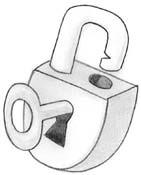The 1-2-3 Magic Workbook for Christian Parents: Effective Discipline for Children 2-12 (12 page)
Read The 1-2-3 Magic Workbook for Christian Parents: Effective Discipline for Children 2-12 Online
Authors: Thomas W. Phelan,Chris Webb
Tags: #Family & Relationships, #Parenting, #General

ried along because I wanted to get out of this noise-filled place. I got to
the check-out line. The racket behind me started getting louder. Here
they come! This lady and her unhappy son got in the next line, and she
checked out sooner than I did because she had fewer items. With great
relief I watched her leaving the store, with her son still tantruming. As
she passed the bubble-gum machine for the second time, she stopped and
bought her son a piece of gum!
I was dumbfounded. I almost lost all my professional decorum right
there. I wanted to jump over the counter, run up to this woman, and say,
“Excuse me, maam, you don’t know me, but I’m a clinical psychologist.
Could I talk to you for a moment?” This mother had just rewarded a
twenty-minute tantrum.
There may be times out in public when, in spite of everything you’ve
done, your child won’t stop a tantrum. Your choices then are these: Gut
it out and finish your shopping (you will feel foolish), take the child out
to the car until he does stop screaming, or go home.
Don’t Take Them Unless You Have To
Have you ever been to church on Sunday, and in the row ahead of you
there is a couple with a two-year-old? The two-year-old, of course, isn’t
paying any attention to the service. Neither are his parents, since they are
preoccupied with trying to keep their son in line so he won’t bother other
people. Finally, around this family trio are ten other individuals who aren’t
paying any attention to the service either, because they’re busy evaluating
how well the couple is disciplining their two-year-old.
So, in effect, we have thirteen people who might as well have not
gone to church at all. Of course, we’re not trying to talk you out of going
WHAT TO DO IN PUBLIC 61
to church, but think before you go anywhere. Don’t ask for unnecessary
trouble in public by putting your kids in situations they simply can’t
handle. In our church example, while the parents are trying their hardest
not to allow their son to bother the other people around them, these other
people are being distracted anyway.
Riding in the Car
Travelling in the car is a kind of half-public, half-private experience which
can present parents with some extremely difficult and even dangerous
situations. Travelling parents often feel like an unwilling captive audience
to their children’s misbehavior. And making matters worse, moms and
dads also know their discipline options are limited.
Have you ever been riding along an interstate with your left hand
on the steering wheel while your right hand is waving madly through the
back seat trying to grab the kid who’s just been teasing his sister for the
fifty-seventh time since you left the last town? Vacations are supposed
to be fun, but this kind of routine is not fun. I’ve had many parents tell
me that they pretty much stopped taking vacations because of nasty and
repeated scenes like these.
Counting is very useful when chauffeuring the kids around town.
The question, of course, is what to do at 3. Time-out alternatives are one
choice. One couple, for example, didn’t allow anyone to talk—including
Mom and Dad—for fifteen minutes after the kids hit 3 for behavior like
teasing, fighting or badgering. Other families have used fines (money
taken off the allowance), at the rate of about five cents for each minute
that would have been included in the child’s normal time out.
You can also do an old-fashioned time out. Where is the time-out
room? You’re riding in it! Your car is actually a stylish, gas-guzzling time-
out room. Over the years a very effective tactic for many of my parents
was 1-2-3, then pull the car off to the side of the road for the rest period.
This strategy is dramatic and has quite an impact on the children.
For some reason, counting the kids in the car and having them serve
the time outs when they get home doesn’t work as well, unless you’re
very close to home. The problem may be that the rest period comes too
long after the offense. In addition, the demand for a time out when you
walk in the door may simply start another fight, because often by the time

62 1-2-3 MAGIC
you get home everybody has forgotten the original problem.
On longer car rides and on vacations, counting can also be used ef-
fectively, just as it is with short trips. But other tactics are often helpful.
Other tactics that parents have used successfully in the car include the
usual—and very helpful—activities like the alphabet game and car bingo.
Putting one child in the front and one in the back has been useful, as has
using a VCR or DVD player (and renting twenty movies!) or leaving at
4:00 in the morning so the kids sleep away the largest part of a four- or
five-hour ride. Telling the kids they get fifty cents for every goat they see
is also a brilliant maneuver.
The main point is this: Don’t ever leave on a car ride with the kids—
or especially on a long “vacation”—without putting on your thinking cap
first. Have the 1-2-3 and a few other tactics in your hip pocket, because
you’re going to need them.
Key Concepts...
Even though it’s not easy, the long-term welfare of
your children should come before your short-term
worries about what other people are going to think of
you as a parent. So when you’re out of the house with the
family, be prepared and stick to your guns!

8
Variations: Sibling Rivalry,
Tantrums and Pouting
Sibling rivalry—a pastime for kids,
a torture for parents
Three common but aggravating childhood problems require a few mi-
nor modifications in our counting procedure because of their unique
natures. The first issue involves sibling rivalry, which many parents put
at the top of their List of Hugely Aggravating and Repetitive Behavior
Problems. The other two behaviors are temper tantrums and pouting.
Sibling Rivalry
When you have more than one child acting up, your life has just become
more complicated. There are more actors in the drama. How are you
going to handle the situation? There is no need to make things more
complex than necessary. Here are a few simple and important rules that
you should follow:
Count both kids
. When the children are fighting, you should count
both kids most of the time, because
usually
they both helped produce the
conflict. Kids are tricky; some provoke in subtle ways and others in more
aggressive ways, so it is often hard to tell who started a fight—even if
you are right there.
63

64 1-2-3 MAGIC
For example, have you ever been driving in the car with the kids in
the back and you hear, “Mom, he’s looking at me again!”? Who started that
one? There’s really no way to tell. So you count both children, unless one
is the obvious, unprovoked aggressor and you’re absolutely positive.
Never ask the world’s two stupidest questions
.
Every parent
knows what these questions are: “What happened?” and “Who started
it?” What do you expect to hear, a version of George Washington’s “I
cannot tell a lie”? “Yes, I started this fight and
CAUTION
the last thirteen consecutive squabbles have also
been
Never ask the
my personal responsibility.” That kind of
world’s two
confession won’t happen. Instead, all you get is
stupidest questions:
“Who started it?” and
the kids blaming one another and yelling.
“What happened?” unless There are, of course, times when you might
you think someone is
need to ask what happened. If, for instance, you
physically injured. Do you think someone might be physically injured, you
expect your kids to come
up with George
would want to examine the child and find out
Washington’s version of
what caused the injury. The same thing might
“I cannot tell a lie”?
be true with other serious or unusual cases. But
for your run-of-the-mill sibling rivalry, trying to
find out what happened is too often a lost cause.
Don’t expect an older child to act more mature during a fight
than a younger child
.
Even if your two kids are eleven years old and four years old, don’t say to the eleven-year-old, “She’s only a baby; can’t you
put up with a little teasing?” That comment is the equivalent of loading
the gun of the four-year-old, who will be sure to both appreciate your
generosity and to take maximum advantage of it.
Along these same lines, imagine for a second that your eleven-year-old
son comes up to you one day and says, “I want to ask you a question.”
“Go ahead,” you say.
“How come I always get a ten-minute time out, and Miss Shrimp
over there (your four-year-old) only has to go for five minutes?”
“Because the rule in our house,” you say, “is one minute of time out
for each year of your life.”
“WELL THAT’S THE DUMBEST THING I EVER HEARD OF!”
“That’s 1.”
VARIATIONS: SIBLING RIVALRY, TANTRUMS AND POUTING 65
This child doesn’t really want information. He wants a fight, but
don’t get sidetracked into a useless argument. With
1-2-3 Magic
we have
a rule that goes: Count attacks and discuss discussions.
What if the kids have a fight and they share the same room?
It
would not be a good idea to send two fighting children to the same time-
out place to continue their fight. Send one to his room and the other to
an alternate time-out room or place. Then for the next rest period reverse
the locations. Or use time-out alternatives when both children fight. If
your kids have separate bedrooms and they fight on the way to their rest
periods, extend the time outs by five or ten minutes.
Temper Tantrums
Let’s say your son got timed out for tantruming. He’s now in his room and
he’s still having a fit. The problem here is simple: What if the time-out
period is up but the child’s not done with the tantrum? You don’t want to
let him out in his condition and, in a sense, he’s just earned another time
out. The answer to this dilemma, fortunately, is also simple: The time out
doesn’t start until the tantrum is over. So if it takes the youngster fifteen
minutes to calm down, the rest period starts after fifteen minutes. And if
it takes the kid two hours to calm down (could be a room-wrecker), the